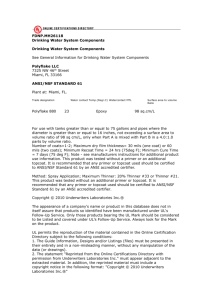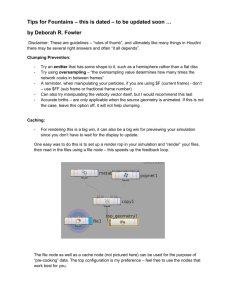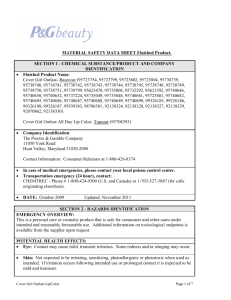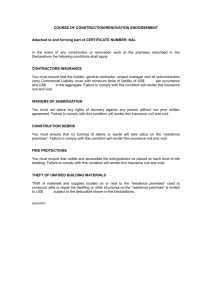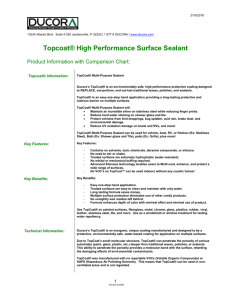Appendix 2 - Specification
advertisement
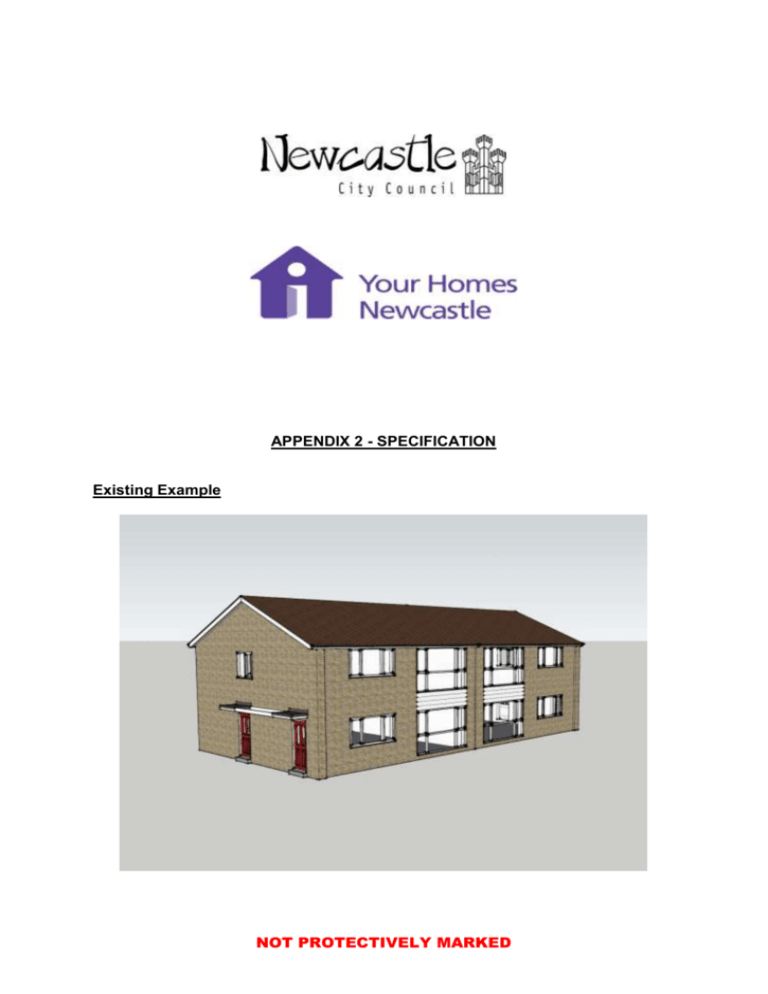
APPENDIX 2 - SPECIFICATION Existing Example NOT PROTECTIVELY MARKED Proposed Example Alsecco Flexewall Impact M20 External Render System Type(s) of coating Alsecco Systems: Alsecco External Wall Render System. Must be applied in strict accordance with the manufacturer’s written recommendations by a contracting partner from Alsecco UK Ltd’s current list. Proprietary Render: Alsecco 'Flexewall Impact' Anti-Crack Render System. System Materials and Components In all cases, substrate should be deemed fit for purpose prior to the application of Alsecco External Render System. 1.1 System Components Note: Basecoat TZ1 should not be used on AAC or Lightweight Blockwork: Please contact Alsecco Technical for advice on a job to job basis. Sub Primer: Sub Primer HT/P if required Base Coat: Basecoat TZ1 (10-15mm) & Universal Mesh NOT PROTECTIVELY MARKED 1.2 Accessories Top Primer: Top Primer SC Top Coat: Silitect T1.5 Base Rail: B15 – PVCu. Stop Beads: RS15 PVCu. Corner Beads: CB14 PVC 14-16mm Corner Bead. Sealing Strip 13/2: Optional. Balcony Drip Required Only Where Present In Substrate. Bead: Notes: Preparation of existing surfaces: Ensure existing substrate is clean, sound and free from all adhesive reducing residue/surface contaminants. Refer to recommendations of BSEN13914-1:2005 including annex B. Bond tests/Sample area recommended prior to complete application. System Material and Component Description 1.3 Starter Bead: 1.4 Substrate Primer: 1.5Beading: 1.6 Reinforcing Coat: 1.7 Reinforcement: Stainless Steel horizontal starter bead, 2m long. Starter beads shall be fixed to all masonry substrates with zinc-coated carbon steel hammer-drive fixings and to wooden substrates with pan-head or washer-head stainless steel wood screws. Size, length and spacing of fixings to be in accordance system manufacturers recommendations. Contractor to ensure that system complies with CP3: Chapter V: Part 2: 1972 in relation to its structural stability. In accordance with Section 1.1 Provide beads and stops at all external angles and stop ends except where detailed otherwise. See section 1.2 for Reference. In accordance with Section 1.1 Reinforcement shall be Specified Alsecco Reinforcing Mesh as per Section 1.1 & Clause 1.6 with symmetrical interlaced glass fibre made from twisted multi-end strands, coated to provide a high resistance to alkali attack and is manufactured so as to prevent laminar movement and deformation. NOT PROTECTIVELY MARKED 1.8 Topcoat Primer: 1.9 Topcoat: Execution Provide beads and stops at all external angles and stop ends except where detailed otherwise. See section 1.2 for Reference. In accordance with Section 1.1 2.1 All installation of Alsecco materials in the UK shall be performed by Alsecco Contracting Partners. Under no circumstances shall any of the Alsecco products be altered with any additives, except for small amounts of clean water as directedon the label. 2.2 If required, apply Alsecco Sub primer to substrate. (See section 1.1 for reference.) All substrate must be free of loose particles, dusting, grease and oils. 2.3 If required, a fungicidal wash must be applied. 2.4 All exposed metal work to be covered by an appropriate primer e.g. Disbon or similar and left to dry prior to the application of Alsecco insulation with anti-Crack Render. 2.5 If substrate is of poor alignment and levelling is required, use Alsecco TZ1 basecoat (without reinforcing mesh). Not suitable for lightweight or AAC Blockwork. Dubbing out using TZ1 shall be no more than 30mm in depth. For further advice contact the Alsecco technical department. 2.6 Align starter track and fix with Alsecco anchors spaced at a maximum of 300mm apart - ensure that the base rail is not distorted. Corners should be made with mitred cuts, or an Alsecco pre-formed corner section. Alternatively, fix starter track in continuous dab of specified Basecoat render. Level and line can be adjusted using Alsecco spacers available in a range of sizes. 2.7 Fix corner bead with continuous dab of basecoat render at corners and align until NOT PROTECTIVELY MARKED plumb. Ensure correct line, level and square fixing of corner beads. 2.8 For starter tracks and corner beads fixed with continuous dab of basecoat mortar, allow approx. 12 to 24 hours drying time, depending on weather conditions. Subsequent rendering or finishing work must NOT be carried out until mortar has set. 2.9 All beads should be cut neatly, mitres formed at return angles and sharp edges, swarf and other potentially dangerous projections removed. Fix securely, using the longest possible lengths, plumb, square and true to line and level, ensuring full contact of wings with background. After coatings have been applied, remove coating material while still wet from surfaces of beads/stops, which are to be exposed to view. 2.10 Apply Alsecco Basecoat render (as specified in Section 1.1) to the sound substrate approximately 1-2mm shallow of final specified depth (see Section 1.1) using a stainless steel trowel. Level out using a plasterer's straight edge. Float specified reinforcing mesh (see section 1.1) into the top of the basecoat render, ensuring a minimum horizontal and vertical overlap of 100mm for the glass mesh. All corners at openings must be additionally reinforced with 250 x 250mm mesh strips embedded diagonally into the wet basecoat render. Immediately apply additional layer of 12mm of basecoat render while still wet and smooth off to finished thickness using a stainless steel trowel. Leave basecoat render to set for at least 2 to 3 days before applying Alsecco topcoat renders. 2.11 Apply allocated Alsecco Topcoat Primer (see section 1.1) to dry basecoat render using a short pile roller, prior to applying stated Alsecco Topcoat. Drying time 2-6 hrs (Weather dependant). 2.12 Prior to the application of topcoat, all NOT PROTECTIVELY MARKED 2.13 2.14 scaffolding boards should be cleaned to ensure minimum dirt being transferred onto the finished topcoat. As the topcoat is a finishing trade, work sequencing should ensure that little or no work is carried out around the render after application of topcoat. Where Scaffold plugs are to be retained, appropriate Scaffold Ties to be used in accordance with system details. Apply specified topcoat render (see section 1.1) using a stainless steel trowel and immediately create the desired effect using a plastic finishing trowel. Drying time of topcoat render is approximately 1 to 2 days (weather dependant The topcoat render, is applied in accordance with the following general rules: a Using a clean, rust-free low speed mixer, thoroughly stir the Alsecco finish to a uniform consistency. b Finish shall be applied in a continuous application always working to a wet edge. Care should be taken to avoid texture changes at different levels. To prevent staining of the finish coating, always ensure that the scaffold boards are free from dust before commencing application of the final coat. If possible, entire sections or elevations should be coated in a single operation to avoid joint marks in the finish. Often this can be achieved by working to natural breaks in the building or changes in colour or texture. Where day-joints are unavoidable these should be made to coincide with natural features such as a line of window cills. Apply a masking tape at the desired position of the joint and apply the finish overlapping the edge of the tape. Carefully remove the tape while the finish is still wet to leave a fair edge. Once the finish material has set subsequent applications may be applied by masking the previously completed section with tape and carefully applying the new finish to achieve a barely visible joint. c Only in situations where mineral renders (Miratect & Alsilite) are to be used, irregular shading and patching due to uneven drying cannot always be avoided. NOT PROTECTIVELY MARKED Evenness of colour can be achieved by applying ALSECCO Equalising finish. d. Weather conditions will be a factor in the application of the finish as well as the drying time. e. An option for areas of high salt-water attack, a final coat of Alsecco Alsicolor Quatro can be applied. Protection and Cleaning 3.1 All installation of Alsecco materials in the UK shall be performed by Alsecco Contracting Partners. Under no circumstances shall any of the Alsecco products be altered with any additives, except for small amounts of clean water as directed on the label. 3.2 All plasters described should never be applied if ambient and surface temperatures cannot be kept above +3°C for mineral products, +5°C for acrylic and silicon products and +1°C for ice products during application and drying period. Prior to installation, the wall shall be free of residual moisture. The stored material should be protected from frost and strong sunlight. Although it is preferable when working with highly pigmented renders to mask or protect other building elements such as windows, sills, etc., spilled or dropped materials may be removed easily from most surfaces with a wet sponge or cloth before the material has dried out. Renders which have been allowed to partially dry may be removed by using a soap solution to soften the render and warm water to clean the surface. Absorbent surfaces such as concrete, brick, etc. maybe affected by the pigments of the render and where spillage is likely then these surfaces should be protected with appropriate covering material. Although it is preferable when working with highly pigmented renders to mask or protect other building elements such as windows, sills, etc., spilled or dropped materials may be removed easily from most surfaces with a wet sponge or cloth before the material has dried out. Renders which have been allowed to partially dry may be removed by using a soap solution 3.3 3.4 NOT PROTECTIVELY MARKED to soften the render and warm water to clean the surface. Absorbent surfaces such as concrete, brick, etc. maybe affected by the pigments of the render and where spillage is likely then these surfaces should be protected with appropriate covering material. General Comments 4.1 Remove efflorescence, dust and other loose material by thoroughly dry brushing. Remove all traces of paint, grease, dirt and other materials incompatible with coating by scrubbing with water containing detergent and washing off with plenty of clean water. Allow to dry before applying coatings unless specified otherwise. 4.2 Prepare backgrounds as specified for the type of coating to be applied. Methods other than those specified may be submitted for approval. 4.3 Biocides must be approved and registered by the Health and Safety Executive (HSE) and listed in the current ‘Reference Book 500’, as surface biocides. 4.4 Apply each coating firmly to achieve good adhesion and in one continuous operation between angles and joints. All coatings to be not less than the thickness specified firmly bonded, of even and consistent appearance, free from rippling, hollows and ridges. Finish surfaces to a true plane, to correct line and level, with all angles and corners to a right angle unless specified otherwise, and with walls and reveals plumb and square. Prevent excessively rapid or localised drying out. The standard at finish meet the requirements of BSEN 13914-1: 2005 NA.15 assessment of external rendered finishes Alsecco would recommend where possible that the variation in gap under a 1.8m straight edge (with feet) placed anywhere on the surface to be not more than 3mm. NOT PROTECTIVELY MARKED Additional Info 4.5 Work in the shade and out of drying winds whenever possible. Allow each coat to dry out thoroughly to ensure that drying shrinkage is substantially complete before applying next coat. 4.6 Adequately protect newly applied external coatings against frost and rain for the first 48 hours using polyethylene sheet / Debris netting hung clear of the face, or other approved method. All substrates must be sound, even (DIN 18202 or 18203, as applicable), clean and free from adhesion-reducing residue. Hammer testing of the substrate is recommended and any loose or crumbling debris removed, application onto any painted substrates must be subject to Alsecco Technical approval. Where levelling or dubbing out of the substrate is required; clean the substrate adequately and apply primer if necessary on the area to be filled. Level or dub out the target area using Alsecco TZ1 basecoat (without mesh, levelling depth not exceeding 30mm) drying time approx. 2 - 4 days Dependent on temperature, layer thickness and relative humidity. For layer thicknesses greater than 15 mm apply several layers with an interval between each one and roughen the surface of the last layer in each case thoroughly with a coarse broom to provide a key. Please refer to “BS EN 13914-1:2005; Design, preparation and application of external rendering and internal plastering. External rendering” for a comprehensive guide to preparing substrates. NOT PROTECTIVELY MARKED
